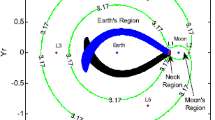Abstract
The current work analyzes the delta-V characteristics to deploy a lunar CubeSat impactor for an early phase feasibility study. The lunar CubeSat impactor is assumed to ride on the mothership and be deployed to hit the lunar surface during a flight inside the lunar sphere of influence (SOI). Different combinations of the periselene approach altitude and velocity for the mothership are considered to cover different flight trajectory environments, and the relevant optimal control problem is formulated under two-body dynamics for an early stage analysis. The CubeSat deployment moment is also varied to observe the associated affects. As a result, the optimal delta-V magnitude and direction characteristics with respect to different deployment times are analyzed and discussed via an example impact trajectory. Earlier deployment is preferable in the current conceptual mission not only for conserving delta-V, but also from the point view of a real-world ground operational timeline. In terms of the final impact conditions observed, the strongest candidate science that can be accomplished with the proposed concept would be to measure the lunar magnetic anomalies during the impact phase. The proposed CubeSat deployment strategy could be a more reliable choice because it can be accomplished with a delta-V that is similar to that in previous work while minimizing the effects on the original design baseline of the mothership’s flight trajectory. Moreover, the proposed approach is applicable to any type of planetary mission, lander or orbiter and to any planet.







Similar content being viewed by others
References
Jet Propulsion Laboratory (2019) https://www.jpl.nasa.gov. Accessed 15 Jan. 2019
Klesh AT, Baker JD, Bellardo J et al (2013) INSPIRE: interplanetary nanospacecraft pathfinder in relevant environment. In: Proceedings of AIAA SPACE 2013 Conference and Exposition, AIAA 2013-5323, 10–12 Sept, San Diego
Bambach P, Deller J, Vilenius E et al (2018) DISCUS—the deep interior scanning CubeSat mission to a rubble pile near-Earth asteroid. Adv Space Res 62(12):3357–3368
Perez F, Modenini D, Vázquez A et al (2018) DustCube, a nanosatellite mission to binary asteroid 65803 Didymos as part of the ESA AIM mission. Adv Space Res 62(12):3335–3356
Alkalai L (2018) CubeSats and small satellites as a vehicle for space innovation and exploration of space beyond Earth orbit. In: 4th IAA Conference on University Satellite Missions and CubeSat Workshop, 4–7 Dec, Rome
Song Y, Lee D, Kim Y et al (2018) Flight dynamics & navigation for planetary missions in Korea: the past efforts, recent status and preparing future. J Astron Space Sci 35(3):119–131
Garrick-Bethell I, Lin RP, Sanchez H et al (2013) Lunar magnetic field measurements with a cubesat. In: Proceeding of SPIE 8739, sensors and systems for space applications VI, 873903
Song Y, Jin H, Garick-Bethell I (2015) Lunar CubeSat impact trajectory characteristics as a function of its release conditions. Math Probl Eng 2015:681901
Song Y, Jin H, Kim B (2015) Preliminary analysis of Delta-V requirements for a lunar CubeSat impactor with deployment altitude variations. J Astron Space Sci 32(3):257–268
VACCO Industries (2019) https://www.cubesat-propulsion.com. Accessed 17 Jan 2019
Song Y, Lee D, Jin H, Kim B (2017) Potential trajectory design for a lunar CubeSat impactor deployed from a HEPO using only a small separation delta-V. Adv Space Res 59(2):619–630
Lan W, Munakata R, Nugent LR et al (2007) Poly picosatellite orbital deployer Mk. III Rev. E user guide. CP-PPODUG-1.0-1. California Polytechnic State University, California
Vallado DA (2013) Fundamentals of astrodynamics and applications, 4th edn. Microcosm Press, California
Brown CD (1998) Spacecraft mission design, 2nd edn. American Institute of Aeronautics and Astronautics Inc, Reston
Gill PE, Wong E, Murray W et al (2015) User’s guide for SNOPT version 7.5: Software for large-scale nonlinear programming. University of California, California
Schultz PH (1996) Effect of impact angle on vaporization. J Geophys Res Planets 101(E9):21117–21136
Vaughan WM, Head JW (2014) Impact melt differentiation in the South Pole-Aitken basin: some observations and speculations. Planet Space Sci 91:101–106
Sridharan T, Ahmed SM, Das TP et al (2010) ‘Direct’ evidence for water (H2O) in the sunlit lunar ambience from CHACE on MIP of Chandrayaan I. Planet Space Sci 58(6):947–950
Marshall W, Shirley M, Moratto Z et al (2012) Locating the LCROSS impact craters. Space Sci Rev 167(1–4):71–92
Burchell MJ, Robin-Williams R, Foing BH (2010) The SMART-1 lunar impact. Icarus 207(1):28–38
Burchell MJ, Cole MJ, Ramkissoon NK et al (2015) SMART-1 end of life shallow regolith impact simulations. Meteorit Planet Sci 50(8):1436–1448
Garrick-Bethell I, Russell CT, Warwick S (2017) NanoSWARM: a discovery class lunar mission to study space weathering, the solar wind, surface water, and remanent magnetism. In: Low-Cost Planetary Mission Conference, 15–17 Aug, Pasadena, CA, LCPM-12, 23
Acknowledgements
This work is partially supported by NRF-2014 M1A3A3A02034761 through the National Research Foundation (NRF) funded by the Ministry of Education of Korea.
Author information
Authors and Affiliations
Corresponding author
Additional information
Publisher's Note
Springer Nature remains neutral with regard to jurisdictional claims in published maps and institutional affiliations.
Rights and permissions
About this article
Cite this article
Song, YJ., Lee, D., Jin, H. et al. Preliminary Delta-V Analysis to Deploy a CubeSat Impactor from the Mothership During a Flight Inside the Lunar Sphere of Influence. Int. J. Aeronaut. Space Sci. 21, 277–289 (2020). https://doi.org/10.1007/s42405-019-00234-w
Received:
Revised:
Accepted:
Published:
Issue Date:
DOI: https://doi.org/10.1007/s42405-019-00234-w




